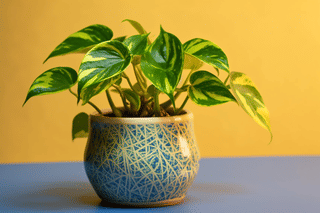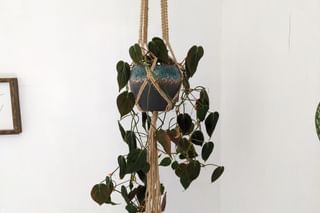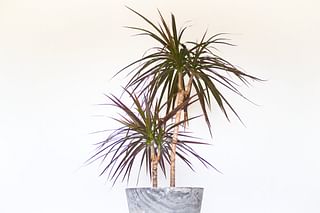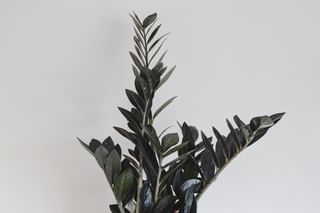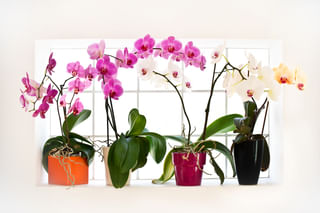8 Amazing Yet Cheap Houseplants for Your Home
Discover 8 incredible and affordable houseplants that will transform your home into an indoor jungle! I'll guide you through each plant's unique features and care tips, helping you to choose your next cheap houseplant. Get ready to bring nature indoors without breaking the bank. Let's begin this green journey together!
Have you seen a great plant at the gardening store but were disappointed by how expensive the plant was? "The cheaper plants are all boring" I can hear you say. But nothing is further from the truth. There are quite a few amazing-looking houseplants that don't have to break the bank.
If you're looking for great-looking, easy-to-care-for, and budget-friendly houseplants, you're in the right place. Here are eight amazing yet cheap houseplants that are perfect for your home.
Golden Pothos (Epipremnum aureum)
The Golden Pothos, also known as Devil's Ivy, is a well-known low-maintenance, and tough houseplant that's a great choice for beginning plant owners. It does well in a variety of lighting conditions, from low to bright indirect light, but it does best in medium indirect light. The watering needs of Golden Pothos are minimal too, it prefers to be kept on the drier side rather than waterlogged.
When it comes to long-term care, the Golden Pothos is a fairly forgiving plant. It's a fast grower, so you might find yourself needing to prune it back a few times per year to keep its size manageable. Pruning also encourages fuller growth, making your plant bushier. Repotting is usually only necessary every couple of years or when you see roots growing out of the drainage holes of the pot. If you're looking to propagate or multiply your Golden Pothos, simply snip a cutting just below a leaf node and put it in a jar with water. After a few weeks, roots will start to grow.
For more in-depth information about this resilient, budget-friendly houseplant, check out my Complete Guide to Golden Pothos Care.
Philodendron Micans
Philodendron micans is a unique and low-cost houseplant with velvety, heart-shaped leaves that come in a beautiful range of colors. It can thrive in bright, indirect light, or even low light, making it a versatile option for any spot in your home. To water the plant, wait for the top inch of soil to dry before watering again. This watering schedule helps prevent overwatering and reduces the risk of root rot, ensuring the plant stays healthy.
Philodendron micans is similar in terms of long-term maintenance to Golden Pothos. It grows fairly fast, so occasional pruning and repotting every couple of years or when roots appear is recommended. Propagation is simple: just cut a stem below a node and place it in water until roots appear. If you're new to plant care or want an easy-care option, this could be perfect for you.
For more detailed information about this stunning, budget-friendly houseplant, head over to my Complete Guide to Philodendron Micans Care. Learn all the tips and tricks to keep this plant looking its best in your home.
Tradescantia Zebrina
Tradescantia Zebrina, also known as the Wandering Dude, is a fantastic houseplant with vibrant, striped leaves in shades of purple, green, and silver. It's remarkably resilient and can thrive in different light conditions, although it loves bright, indirect light the most. You'll know when it needs watering when the leaves look a bit deflated or wilted. This visual cue prevents overwatering, a common mistake in plant care.
Taking care of Tradescantia Zebrina is a breeze. It grows relatively quickly, so occasional pruning helps keep it in shape and promotes lushness. Repotting is only necessary every 2-3 years or when the plant outgrows its pot. Propagation is also quite simple. Snip off a stem, put it in water, and wait for roots to develop. This plant's low-maintenance nature, combined with its stunning appearance, makes it a perfect choice for any indoor garden.
If you're interested in learning more about this fantastic, budget-friendly houseplant, be sure to check out my Complete Guide to Tradescantia Zebrina Care. There, you'll find all the best tips and tricks to keep this plant vibrant and flourishing in your home.
Dracaena Marginata
The Dracaena Marginata, also known as Dragon Tree, is a great choice for those who want a low-maintenance and budget-friendly houseplant. It has long, thin leaves that gracefully arch from a central stem, giving it an elegant look. This plant can thrive in bright or low light conditions, making it adaptable to different indoor environments. To water it, let the top 2 inches of soil dry before watering again. The Dracaena Marginata is resistant to common houseplant pests, so you won't have to deal with them often.
For long-term care, this plant grows slowly to moderately, so you won't need to prune it frequently. When you do prune, you're not just controlling its size but also encouraging branching for a fuller and more attractive appearance. Repotting should be done every 2-3 years or when you see roots overcrowding the pot. Propagation is simple; just cut a stem section, let it dry for a day or two, then plant it in fresh soil. The Dracaena Marginata is a tough and easy-to-care-for plant that adds an exotic touch to any home without breaking the bank.
If you're interested in diving deeper into the care of this elegant and budget-friendly houseplant, don't hesitate to visit my Complete Guide to Dracaena Marginata Care. This comprehensive guide will equip you with all the necessary knowledge to keep your Dragon Tree thriving.
ZZ Plant (Zamioculcas Zamiifolia)
The ZZ Plant, also known as Zamioculcas Zamiifolia, is a favorite among plant enthusiasts for good reason. It's a low-cost houseplant with bright, waxy leaves that add a whole new texture to your living spaces. This resilient plant can thrive in a wide range of light conditions, from low to bright, indirect light. Watering is a breeze; simply let it dry out completely between waterings. Its drought-tolerant nature is perfect for those who sometimes forget to water their plants.
For long-term care, the ZZ Plant grows slowly, so pruning is minimal. You'll only need to remove yellow or brown leaves, which are normal as part of its growth cycle. You won't need to repot your ZZ plant very often. On average you should do so every 3-4 years or when the plant outgrows its pot. To propagate, divide the plant during repotting or take a stem cutting and plant it in the soil.
If you're keen on learning more about this versatile, budget-friendly houseplant, be sure to learn more in my Complete Guide to ZZ Plant Care.
Monstera Deliciosa

The Monstera Deliciosa, also known as the Swiss Cheese Plant, is an excellent option for those looking for an affordable houseplant with a unique appearance. It has glossy, perforated leaves that really make you feel like you're in the jungle.
Taking care of this plant is easy. It thrives in bright, indirect light and likes to dry out a bit between waterings, so check the top inch of soil before watering. It's tough against common houseplant diseases and pests, making it an ideal choice for new plant parents.
Regular maintenance is simple too. It grows moderately, so you don't need to prune it often, but when you do, it helps maintain its shape and promotes bush-like growth. Repotting is necessary every 2-3 years or when it outgrows its pot. Propagation is straightforward. Cut a stem with a node, put it in water, and the roots will start growing. In summary, the Monstera Deliciosa is a stunning, budget-friendly houseplant that won't demand much time or energy.
If you're excited to know more about how to keep your Monstera Deliciosa thriving, don't miss out on my Complete Guide to Monstera Deliciosa Care.
Anthurium
The Anthurium, also known as the Flamingo Flower, is a vibrant and affordable plant that adds a new color to your home. With glossy, heart-shaped leaves and bright, spathe-style flowers, this tropical plant is surprisingly low-maintenance. It thrives in bright, indirect light but can handle lower light too. Water it weekly or when the top inch of soil feels dry. Mist it occasionally to keep the humidity around the plant high.
For long-term care, the Anthurium has a moderate growth rate, so pruning isn't needed very often. Just remove yellow or brown leaves to keep it fresh. Repot every 2-3 years or when it outgrows its pot. To propagate, divide the plant during repotting or take a stem cutting below a node and place it in water or moist soil. The Anthurium is a beautiful and budget-friendly houseplant that's easy to care for and propagate.
Want to know more about this colorful addition to your houseplant collection? Don't miss my Complete Guide to Anthurium Care.
Orchid
The Orchid is a beautiful and affordable houseplant that's easy to care for. It thrives in moderate to bright, indirect light and prefers well-aerated roots. To achieve this, use a well-draining potting medium like orchid bark or sphagnum moss (no potting soil, this will cause root rot). Water once a week or when the potting medium is dry to the touch, making it easier for those who struggle with a watering schedule. The Orchid is perfect for adding bright, happy colors to any home, even if you're not an experienced gardener.
Like the other plants, maintenance is minimal. Mainly removing spent blooms or yellow leaves. Repot every 1-2 years or when the plant outgrows its pot, a simple task for beginners. Propagation is also easy, just remove a healthy pseudobulb (the swollen part of the stem) and plant it in a new potting medium. The Orchid is a budget-friendly houseplant that brings maximum visual impact with minimal effort.
Dive into my Complete Guide to Orchid Care for all the essential tips and techniques to keep your Orchid looking its breathtaking best.
Conclusion
Houseplants don't have to be expensive or high maintenance to add a bit of greenery to your living space. The eight plants mentioned in this plant care guide are great choices for anyone looking for easy-to-care-for, budget-friendly houseplants. They all come with unique appearances and don't cost too much. By adding these cheap yet amazing houseplants to your home, you'll create a beautiful and healthier living space that you'll enjoy for years to come!
Thank you for reading this post! I hope it helps you to keep your plants healthy and beautiful! If you're looking for more guides on specific plants, you can always request a plant guide to get a guide for the plant you have trouble with.
Test your plant care knowledge
Quiz completed!
Want to learn more? Sign up for my newsletter to receive free tips in your inbox!
Sign up now!
